Jessica from AleHorn here, and I’d like to talk with you about the different traditional mead drinking vessels you can use to get your favorite mead into your mouth hole! You may have found a few meads you really love – the next step is choosing the right cup to really let it shine.
The ideal cup for imbibing any type of alcohol depends on many factors ranging from the aroma, style of the brew, to how the weight of the cup feels in your hand. As you guys know, the taste, nose, and mouthfeel will differ greatly from one mead to another. From light and sparkling to heavy and still, meads can be earthy, flowery, savory, or sweet. Mead is so delicious that we could drink it from our shoes and still love it, but a good cup honors the ancient beverage’s rich history and nuanced flavors while enhancing the whole mead drinking experience.
Large Traditional Vessels
If what you love most about mead is that it was most likely the first alcoholic drink to ever touch human lips and that it has most certainly been around longer than beer and wine, then you’ll feel even more connected to history if you use the type of cup the Norsemen and Celts would have been using long before glass blowing was just a glimmer in some ancient Venetian’s eye.
Besides having the right look and feel to really dig into the roots of mead culture, large traditional vessels like horns, tankards and bowls are the ideal vessel for fully experiencing meads that are robust, woody, and earthy. A mead bouquet is structured in layers, with the lighter, sweeter, fruity flavors lingering at the top while aromas like grass and oak are typically buried underneath. Drinking from a large volume vessel with a large mouth allows you to fully experience all aromas as they decant, changing as they interact freely with the rush of oxygen.
Mead Horns
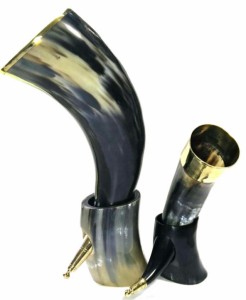 Since alcohol was around long before glass, folks crafted drinking vessels from things close at hand. If a culture raised cattle, there’s a good chance they hollowed out the horns and drank from them. Horns found their way into the mythology of ancient cultures, most notably into the Norse story of how Loki tricked Thor into a drinking contest involving a horn that contained all the seas of the world.
Since alcohol was around long before glass, folks crafted drinking vessels from things close at hand. If a culture raised cattle, there’s a good chance they hollowed out the horns and drank from them. Horns found their way into the mythology of ancient cultures, most notably into the Norse story of how Loki tricked Thor into a drinking contest involving a horn that contained all the seas of the world.
When other drinking vessels became more convenient and inexpensive, drinking horns stuck around as ceremonial vessels, always marking a special occasion and serving as a status symbol for important figures.
In more recent times, Viking style bovine drinking horns have been making a comeback as a result of a renewed cultural interest in ancient ales and meadmaking.
While many soldiers and travelers found drinking horns to be convenient (especially when tied with a leather strap to attach to a belt or pack), a complaint of this type of horn is that it’s difficult to set it down while eating. I have two solutions for you: keep drinking until it’s empty (preferred), or use a horn stand, which sometimes come as part of a set when you purchase a horn.
Tankards
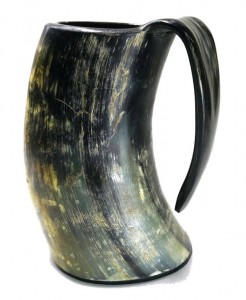 Originally the word tankard meant any wooden vessel, but it later came to mean an ale cup in the shape that we now recognize by that name. Tankards were originally made with wood or pewter, but the recent popularity of fandoms within fantasy realms like that of Tolkien or George R.R. Martin have given rise to the subsequent popularity of tankards made from other material like horn.
Originally the word tankard meant any wooden vessel, but it later came to mean an ale cup in the shape that we now recognize by that name. Tankards were originally made with wood or pewter, but the recent popularity of fandoms within fantasy realms like that of Tolkien or George R.R. Martin have given rise to the subsequent popularity of tankards made from other material like horn.
This is the same pop culture influence that mead makers call the “Game of Thrones effect.” Unlike mead, however, the characters in Game of Thrones are portrayed using horn tankards.
Mazers
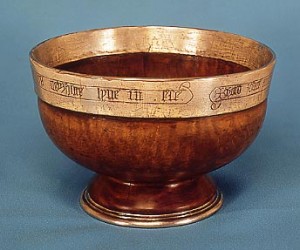 Mazers are wooden or metal drinking vessels that are the size and shape of a soup bowl. For a time they were the most popular and widespread drinking vessels among old Germanic cultures. Mazers ranging from simple wood to intricately inscribed metal would have been found within all types of households.
Mazers are wooden or metal drinking vessels that are the size and shape of a soup bowl. For a time they were the most popular and widespread drinking vessels among old Germanic cultures. Mazers ranging from simple wood to intricately inscribed metal would have been found within all types of households.
In some parts of Scotland, mead is still served in mazers as part of a friendship and welcoming ceremony where the two parties coming together symbolically drink from the same cup.
Modern Glass Vessels

Most modern craft mead found in pubs and tasting rooms are served in glassware similar to that used to serve wine. Wine glasses are a great complement to sweet or semi-sweet meads with crisp, sweet notes of fruit and honey. Because the meadmaker wants the sweeter aromas to shine, they may prefer a delicate glass with a mouth that designed to help nuanced flavors concentrate near the top. Drinking from and even holding a glass makes drinking mead a more formal experience.
The same mead will taste surprisingly different in two different glasses, so consider what type of cup will make you get the most of out of your mead drinking experience. When it comes down to it, there’s no right or wrong – just the right choice for you!
Skål, friends.
Bonus Update: Berele Glassware
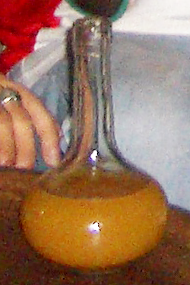 Thanks to a commenter below we can include the existence of a standard drinking glass from the African contingent of mead drinkers. As was stated, African meads have enjoyed a storied history, specifically referencing T’ej, an Ethiopian and Eritrean honey wine made with gesho root. This mead is served in a berele. Similar to a Florence Flask, the berele has a long thin neck above a large round body.
Thanks to a commenter below we can include the existence of a standard drinking glass from the African contingent of mead drinkers. As was stated, African meads have enjoyed a storied history, specifically referencing T’ej, an Ethiopian and Eritrean honey wine made with gesho root. This mead is served in a berele. Similar to a Florence Flask, the berele has a long thin neck above a large round body.
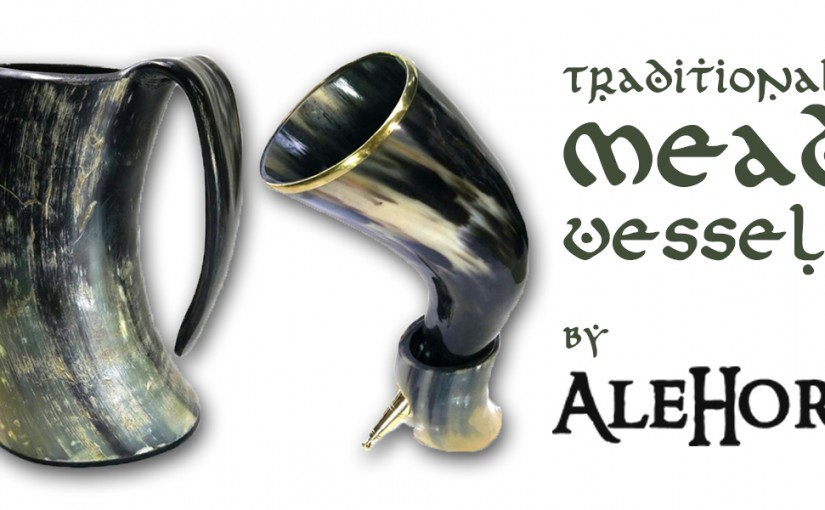
You guy’s skipped over the great berele vessel from Ethiopia. It is customary to drink T’ej, Tej, Ethiopian mead, with one. It is a long or short spouted glass vessel similar to a florence flask or a Orangina bottle. Here are images of bereles:
 , and
, and
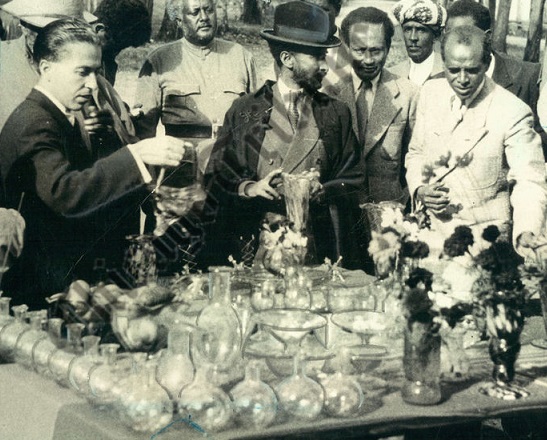 .
.
Mead has been made for centuries in Ethiopia. I believe it is imperative to include Africa in the diverse history of mead. The viking history of mead has dominated modern discourse. Moving beyond vikings is necessary to complete the mead historical narrative.
In short, don’t forget about Africa, a huge continent of rich history, when talking about the history of Mead.
You guys have an awesome thing going on here! I wish you continued success.
Happy Holidays!
Thanks for the heads up! I am familiar with T’ej, but did not know there was a drinking glass associated with it. I’ll add it to the list 🙂
Note: as far as I know it is not the roots of gesho that are used, but the twigs and branches (inchet) and/or the leaves (kitel) Gesho is a species of Buckthorn unique to Eritrea and Ethiopia. It carries the naturally occurring yeasts that ferments the T’ej. The Gesho also flavours the T’ej.
We have heard similar about the root vs twig/branch/leaf issue. Planning on going more in depth in a future podcast. Keep an eye out for it in a few months!
You had me at similar to an Orangina bottle!